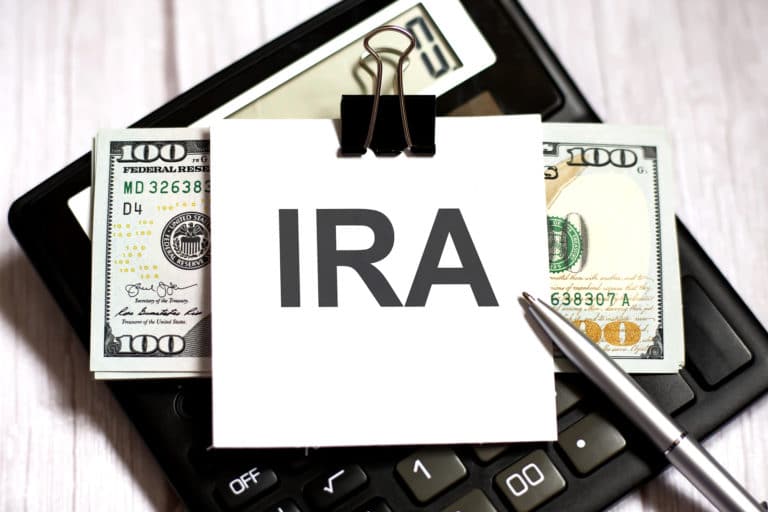Not many people want to go to work every day for the rest of their lives. If you want to be able to stop working and still have the funds to live your life, then you’ll need to start planning now for your retirement. With the right planning and regular contributions, you can have a comfortable retirement.
Unfortunately, many Americans aren’t contributing regularly to any kind of retirement account. While experts recommend that you set aside between 10% and 20% of your annual income for retirement, the reality is that 20% of working Americans are setting aside less than 5% of their income for their retirement.
If you are looking for a way to save for your retirement, then an IRA might be a good option. An individual retirement account is an account you can open at a financial institution that allows for your retirement savings to grow tax-deferred or tax-free. IRAs allow your money to grow over the years and can help you build the wealth you need to maintain your standard of living into retirement.
IRA vs. 401(k)
If you have been looking into options for saving for your retirement, you have probably come across the IRA and the 401(k). While both types of accounts provide a means to save for retirement, they are structurally different and have different benefits and limitations. The 401(k) is an employee-sponsored retirement plan, while an IRA is owned and maintained exclusively by an individual investor.
If you choose a 401(k), your investment options might be limited to funds chosen by your employer/sponsor, however, your possible yearly contributions are much higher. Most employers that offer a 401(k) as a job benefit make yearly contributions that match a certain percentage of their employees’ contributions. Employers and employees make 401(k) contributions pre-tax. This means that the amount you contribute reduces your taxable income for that year.
IRAs are held by investment firms, banks, and other financial institutions and offer a wider range of investment options. You can only contribute $6,000 a year to an IRA account, however, if you choose a Roth IRA, the money you take from the account during retirement will be tax-free. For many people, it is not a question of IRA versus 401(k), but rather, contributing to both kinds of accounts is a great way to set yourself up for retirement.
Who Should Have an IRA?
An individual retirement account is something that many people can benefit from. However, some working adults may benefit more than others. For example, a freelancer, artist, or other self-employed people will not have access to an employer-sponsored retirement plan such as a 401(k). However, an IRA allows them to save for retirement in a way that works for them. There are several types of IRAs, so each self-employed individual can choose an account that fits their needs and goals.
If you are interested in investing your money to grow your wealth for retirement, but you don’t want to manage the investments yourself, then you can open an account with a financial institution and work with an expert or advisor to help you make the best investments. Depending on the type of IRA you choose, your money can be invested in stocks and bonds, but it can also be invested in real estate and alternative forms of investment such as precious metals.
Can You Have More Than One Retirement Account?
Technically, there is no limit to how many IRAs you can have. However, your contributions to all of them combined cannot exceed the maximum annual contribution of $6,000 ($7,000 if you are 50 and older) dictated by the Internal Revenue Service.
While you can only put so much money into your IRAs, you are also allowed to open other types of retirement accounts to increase your retirement savings. Many people have both an IRA and a 401(k) as a part of their retirement plan.
Advantages of an IRA
One of the most immediate benefits of an IRA that most people will notice is how easy it is to set one up. Beyond the initial set-up, your IRA might differ from your other retirement accounts (such as a 401(k)) in that it is entirely yours and is not connected to an employer. If you choose a self-directed IRA, you’ll have complete control of your assets.
In addition, depending on the type of IRA you choose to open, you may be able to deduct your contribution from your taxes, and receive the tax benefits, unless you have a Roth IRA.
Requirements of an IRA
To contribute to an IRA, you need to earn an income. Your contributions to your IRA cannot exceed the amount of money you make each year. If you do not work, but you file jointly with your spouse who does work, then there are IRA options that can work for you.
Before taking money for your account, it’ll need at least five years to sit unused. So if, for instance, you start an IRA account at 57 years of age, you can only start liquidating once you turn 62.
In addition, certain IRA accounts have required minimum distribution (RMD) withdrawals once you turn 72 years of age. In essence, you’re required to take out a certain amount every year after a certain age. On the other hand, Roth IRA accounts don’t have RMDs, so you don’t have to worry about taking out money every year.
How To Open an IRA
Opening an IRA is simple. The main decision you will need to make involves what kinds of investments you want to make with your IRA funds. Different institutions might specialize in different types of investments. Some banks and investment firms may work exclusively with stocks and bonds, while others work with alternative investments.
For example, if you are interested in investing in precious metals like gold, then you would want to work with an investment firm that specializes in gold investments. You can then open a Gold IRA (a Roth IRA that invests in gold instead of stocks).
Once you find the institution that matches your retirement goals and your investment interests, you can open an IRA (most likely a traditional IRA or a Roth IRA), and start investing towards your retirement today.







